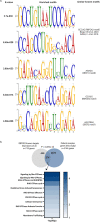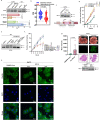RBFOX2 modulates a metastatic signature of alternative splicing in pancreatic cancer
- PMID: 36949200
- PMCID: PMC10156590
- DOI: 10.1038/s41586-023-05820-3
RBFOX2 modulates a metastatic signature of alternative splicing in pancreatic cancer
Abstract
Pancreatic ductal adenocarcinoma (PDA) is characterized by aggressive local invasion and metastatic spread, leading to high lethality. Although driver gene mutations during PDA progression are conserved, no specific mutation is correlated with the dissemination of metastases1-3. Here we analysed RNA splicing data of a large cohort of primary and metastatic PDA tumours to identify differentially spliced events that correlate with PDA progression. De novo motif analysis of these events detected enrichment of motifs with high similarity to the RBFOX2 motif. Overexpression of RBFOX2 in a patient-derived xenograft (PDX) metastatic PDA cell line drastically reduced the metastatic potential of these cells in vitro and in vivo, whereas depletion of RBFOX2 in primary pancreatic tumour cell lines increased the metastatic potential of these cells. These findings support the role of RBFOX2 as a potent metastatic suppressor in PDA. RNA-sequencing and splicing analysis of RBFOX2 target genes revealed enrichment of genes in the RHO GTPase pathways, suggesting a role of RBFOX2 splicing activity in cytoskeletal organization and focal adhesion formation. Modulation of RBFOX2-regulated splicing events, such as via myosin phosphatase RHO-interacting protein (MPRIP), is associated with PDA metastases, altered cytoskeletal organization and the induction of focal adhesion formation. Our results implicate the splicing-regulatory function of RBFOX2 as a tumour suppressor in PDA and suggest a therapeutic approach for metastatic PDA.
© 2023. The Author(s).
Conflict of interest statement
The authors declare no competing interests.
Figures
















Comment in
-
RBFOX2: a key factor in suppressing PDAC metastasis through regulation of alternative splicing events.Signal Transduct Target Ther. 2023 Sep 15;8(1):349. doi: 10.1038/s41392-023-01585-3. Signal Transduct Target Ther. 2023. PMID: 37709754 Free PMC article. No abstract available.
